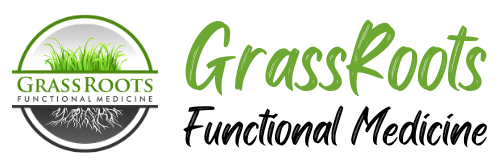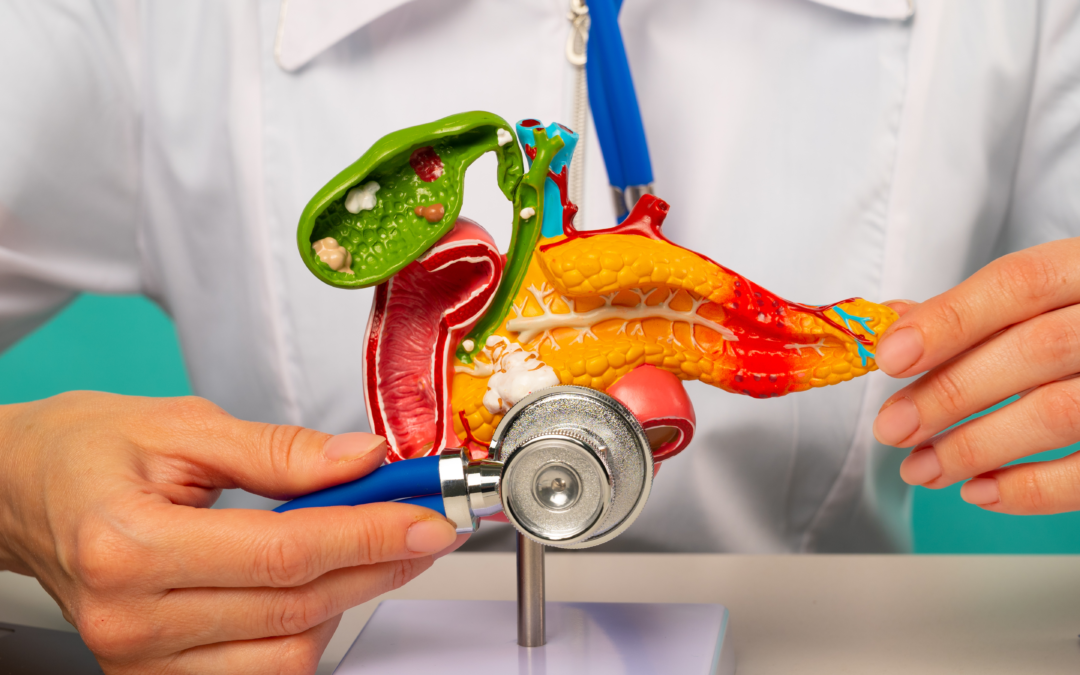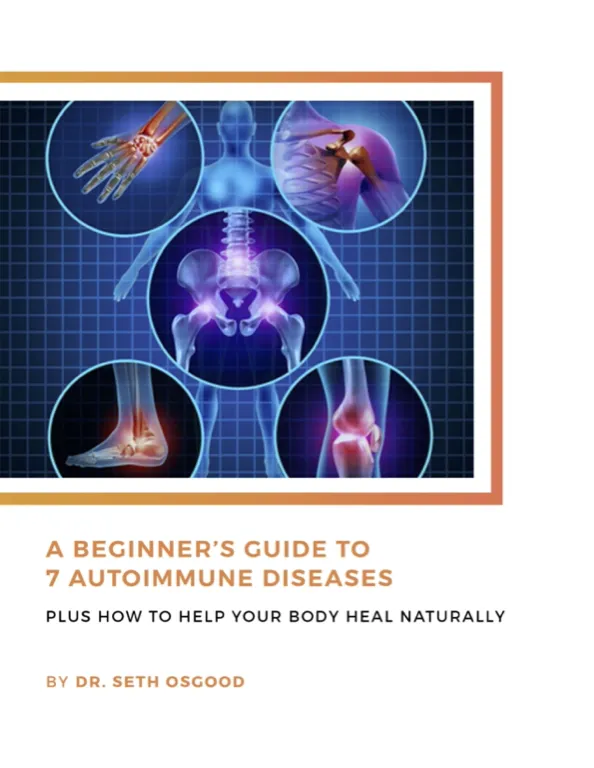The gallbladder is a little pouch located in the upper right abdomen. It collects bile from the liver, concentrates it, and secretes it into the small intestine when we eat a meal containing fat. When bile gets thick or sluggish, this is called biliary stasis. Biliary insufficiency is when the liver is not producing adequate bile. The biliary tree is the name for the web of ducts that branch throughout the liver, collecting the bile as it is being produced and carrying it to the gallbladder for storage. Gallstones can form in the gallbladder if the bile has become congested and isn’t flowing freely.
Bile is important for many reasons. It emulsifies dietary fats, allowing them to be digested and absorbed. Bile enables the absorption of the fat-soluble vitamins: A,D, E, and K. Bile is also an important part of the body’s detoxification system. The liver filters the blood and packages up toxins, cholesterol, and hormones like estrogen that are no longer needed and puts them into the bile to be excreted in the stool.
If someone has had the gallbladder removed, the main biliary duct will increase in size to hold bile, somewhat like the gallbladder did. However, people without a gallbladder often have a continuous drip of bile being released into the small intestine instead of a large amount just at meals, and they may suffer from the symptoms below.
Because the gallbladder plays such an important role in fat digestion, nutrient absorption, and detoxification, you want to do everything you can to keep it as healthy as possible! There are many things you can do to support bile flow and gallbladder health and prevent gallstones. If you relate to many of the symptoms below, it’s a sign that your biliary system could use some extra TLC.
signs of gallbladder dysfunction
- Greasy or high fat foods cause distress
- Lower bowel gas and/or bloating several hours after eating
- Bitter metallic taste in the mouth, especially in the morning and after meals
- Burpy, fishy taste after consuming fish oils
- Unexplained itchy skin
- Yellowish cast to eyes
- Stool color alternates from clay colored to normal brown
- Greasy or shiny stools
- Nausea
- Headache over the eyes
- Reddened skin, especially palms
- Dry flaky skin and/or hair
- History of gallbladder attacks or stones
- Pain between the shoulder blades
In addition to these clinical symptoms, a number of blood work markers suggest an imbalanced liver/gallbladder.
Lab markers
One of the main jobs of the bile is to be the garbage disposal of the liver, flushing waste products that the liver has packaged up (conjugated) into the intestine to exit via the stool. Because of this, we see high levels of certain metabolic waste products in the blood when the bile and gallbladder are backed up and not flowing freely. Three markers to look for on your blood work are Bilirubin, GGT, and Alkaline Phosphatase. If these are high, it could be because your bile is not flowing properly.
Bilirubin is formed when old red blood cells are broken down in the spleen and bone marrow. It travels through the bloodstream to the liver, where it is conjugated and excreted through the bile for elimination. If the gallbladder is sluggish or there are obstructions in the biliary tree, bilirubin can’t be eliminated and builds up in the blood. Levels above 1.2 mg/dL can be a sign of poor gallbladder function. GGT and Alkaline Phosphatase are enzymes that the liver is supposed to excrete through the bile, so when bile flow and gallbladder function are sluggish they can be elevated: over 30 U/L for GGT and over 100 U/L for Alk Phos.
Want to learn more about the comprehensive functional blood work we run on our patients are GrassRoots? Check out this video. Elevated fecal fats on the GI Effects Comprehensive Stool Profile are another sign of gallbladder dysfunction. Watch this video to learn the stool test.
Causes of gallbladder dysfunction
A number of root causes drive a poorly functioning biliary system. Top causes include:
A diet high in unhealthy fats – High Omega-6 polyunsaturated oils contribute to inflammation and impair gallbladder function. These include corn, canola, cottonseed, ricebran, soybean, and safflower oils and are found in processed and fried foods, salad dressings, butter alternatives, crackers, chips, and more. Read labels!
Low fat diets – Since the gallbladder relies on fat in the small intestine to trigger the release of bile, a low fat diet means that bile is not being regularly released from the gallbladder and can become thick and sluggish.
High estrogen – The liver excretes excess estrogen through the bile, and high estrogen, whether endogenous or from exogenous sources such as oral contraceptives and HRT is associated with the biliary system problems.
Low stomach acid – A robust level of HCl in the stomach is the first step in the chain of digestive reactions that includes the release of bile. If low stomach acid is present, it should be addressed first.
Low thyroid – One of the many jobs of thyroid hormone is to tell the liver to make bile and the gallbladder to release it into the small intestine. Hypothyroidism is associated with cholelithiasis (gallstones).
supportive foods and nutrients
A number of whole foods are beneficial for the production and flow of healthy bile. If you know you have gallbladder issues, difficulty digesting fats, or suffer from the symptoms listed above, these are great foods to include in your diet on a daily basis:
- Organic foods (to minimize the toxins/pesticides the liver/gallbladder has to excrete)
- Healthy fats – grass-fed meats, eggs, fish, high-quality dairy (if tolerated), coconut products, avocados, and olive oil
- Choline-containing foods: egg yolks, liver
- Beets, radishes, arugula
- Sulfur-rich veggies: cabbages, onions, broccoli, Brussels sprouts
- Lemons
- Berries
supplements
In addition to a healthy diet, a number of supplements can take stress off of the liver and gallbladder, allowing them to function optimally. These include:
Digestive enzymes with ox bile (RootFix DigestXyme): Enzymes break down the fats, proteins, and carbohydrates in food, and this supplement also contains ox bile, ideal for individuals who are not making enough of their own bile or have had their gallbladder removed.
Stomach acid (RootFix HCl Supreme): Hydrochloric acid breaks down proteins, enables the absorption of nutrients like zinc, B12, and calcium, and triggers the release of enzymes from the pancreas and bile from the gallbladder. To find the dose you need, start with one capsule per meal and increase by 1 capsule until you feel warmness or burning. Decrease by 1 capsule and take that as your dose.
Herbs and nutrients that support the liver (RootFix Liver Shield): Milk thistle has extensive research showing its effectiveness for improving liver function, and this supplement pairs it with NAC, alpha lipoic acid, and selenium for greater antioxidant activity and detoxification support.
B vitamins required for methylation (RootFix MethylAid): One of the pathways whereby the liver conjugates toxins and gets them ready for excretion is called methylation. This process relies on a number of B vitamins: B2, B6, folate, and B12. Many people (in particular those with the MTHFR gene mutation) need high levels of these nutrients and can benefit from a supplement.
lifestyle supports
A nutritious diet and targeted supplementation are the foundation of liver/gallbladder health, but other therapies are helpful, too. Castor oil packs are a great way to gently stimulate bile flow and detoxification. Simply rub a generous amount of hexane-free castor oil over your abdomen, focusing on the upper right quadrant where the liver is; place a piece of wool flannel over it; and apply a hot water bottle or heating pad for 20-40 minutes. Alternatively, you can wear a tie-on castor oil wrap to bed.
next steps
Still struggling with gallbladder issues? Do you feel like your doctors aren’t listening to you, are discounting symptoms, and not doing comprehensive testing to get to the root of the problem? It may be time for a new approach. Work with our team of functional medicine practitioners to get comprehensive testing and a tailored plan to address your unique situation. Check out our Adaptation Programs and schedule a Free Discovery Call to reclaim the vitality you once knew.
About the Author: Dr. Seth Osgood is a Doctor of Nursing Practice, Board Certified Family Nurse Practitioner and Institute of Functional Medicine (IFM) Certified Practitioner. Dr. Osgood received his post-graduate training in Functional Medicine through the IFM and from working with Dr. Amy Myers. He has helped people from around the world improve their health utilizing a Functional Medicine approach.





